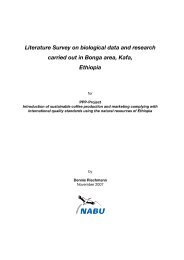Flora Biodiversity Assessment in Bonga, Boginda and Mankira Forest
Flora Biodiversity Assessment in Bonga, Boginda and Mankira Forest
Flora Biodiversity Assessment in Bonga, Boginda and Mankira Forest
Create successful ePaper yourself
Turn your PDF publications into a flip-book with our unique Google optimized e-Paper software.
4.3. Vegetation<br />
Accord<strong>in</strong>g to A. Aalbaek &T.Kide, 1993, the vegetation <strong>in</strong> the study area is found with<strong>in</strong><br />
three seed zones: Western Lower Broadleaved Afromontane Ra<strong>in</strong>forest, Central wet<br />
Bradleaved Afromonatne ra<strong>in</strong>forest <strong>and</strong> Eastern Higher broadleved Afromontane<br />
Ra<strong>in</strong>forest. Friis, 1992 classified the study area as “Afromontane Ra<strong>in</strong> <strong>Forest</strong>”. This<br />
Afromontane ra<strong>in</strong> forest is found on altitudes between 1500 <strong>and</strong> 2500 masl, with average<br />
annual temperature 18-20 0 c <strong>and</strong> ra<strong>in</strong>fall between 1500 mm <strong>and</strong> greater than 2000 mm.<br />
The ra<strong>in</strong>y season is between April <strong>and</strong> October (Friis, 1992).<br />
Accord<strong>in</strong>g to Taye Bekele, 2003, there are three types of vegetation, namely: Upl<strong>and</strong><br />
Ra<strong>in</strong> forest Vegetation, Upl<strong>and</strong> Humid <strong>Forest</strong> Vegetation <strong>and</strong> Ar<strong>in</strong>dunaria/Bamboo<br />
thicket. The author described this zonation based on altitud<strong>in</strong>al variation. The upl<strong>and</strong> ra<strong>in</strong><br />
forest vegetation, upl<strong>and</strong> humid forest vegetation <strong>and</strong> ar<strong>in</strong>dunaria thicket are located at<br />
altitud<strong>in</strong>al range between 1500- 2200, 2450-2800 <strong>and</strong> 2400-3050 masl, respectively. The<br />
current survey is conducted with<strong>in</strong> the three zones. Vegetation listed <strong>in</strong> Taye Bekele,<br />
2003 is <strong>in</strong> agreement with f<strong>in</strong>d<strong>in</strong>gs of the current survey.<br />
In this phytogeography, Friis, 1992 listed 23 tree species as medium sized canopy tree<br />
which can atta<strong>in</strong> 10-30 meter high. These species area:<br />
Albizia gummifera, A. schimperiana, A. gr<strong>and</strong>ibracteata, Blighia unijugata, Cassipourea<br />
malosana, Celtis africana, Croton macrostacheyus, Ekebergia capensis, Euphorbia<br />
ampliphylla, Ficus sur, Ficus ovata, Ficus thonn<strong>in</strong>gii, Ocotea kenyensis,Ilex mitis, Olea<br />
welwitschii, Polycias fulva, Prunus africana, sapium ellipticum, syzygium gu<strong>in</strong>eense <strong>and</strong><br />
Schefflera abyss<strong>in</strong>ica. Friis reported that Pouteria adolfi-friederici is the only emergent<br />
species from a 20-30 meter high canopy. On the other h<strong>and</strong>, Chaffey, 1979, reported that<br />
<strong>in</strong> addition to Pouteria adolfi-friederici, Ficus species <strong>and</strong> Syzygium gu<strong>in</strong>eense are <strong>in</strong> the<br />
canopy. Schmitt C. B., 2006 agrees that the top canopy is occupied by Pouteria adolfifriederici<br />
that can atta<strong>in</strong> a height of above 40 meters. Other trees that can grow up to 40<br />
meters, accord<strong>in</strong>g to the same author, are Olea welwitschii <strong>and</strong> Trilepisium<br />
madagascariense.<br />
44



